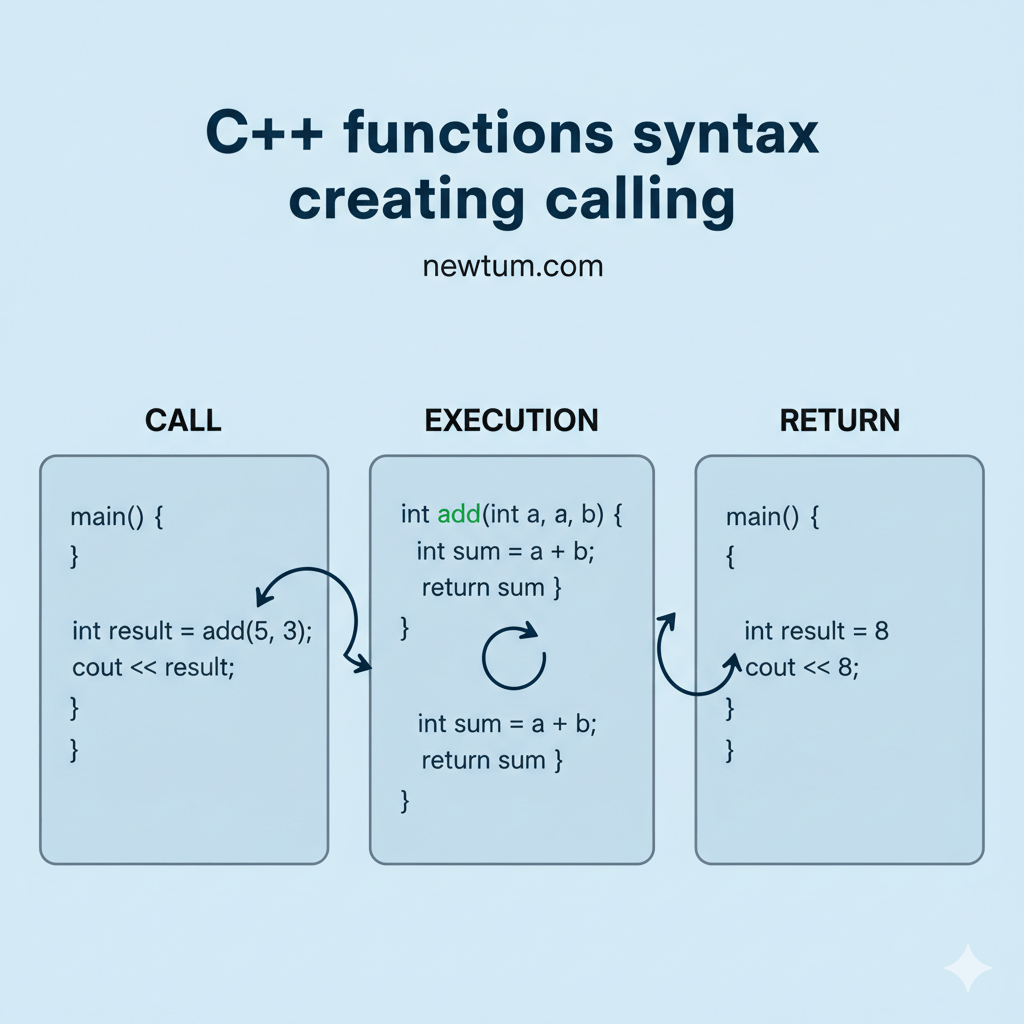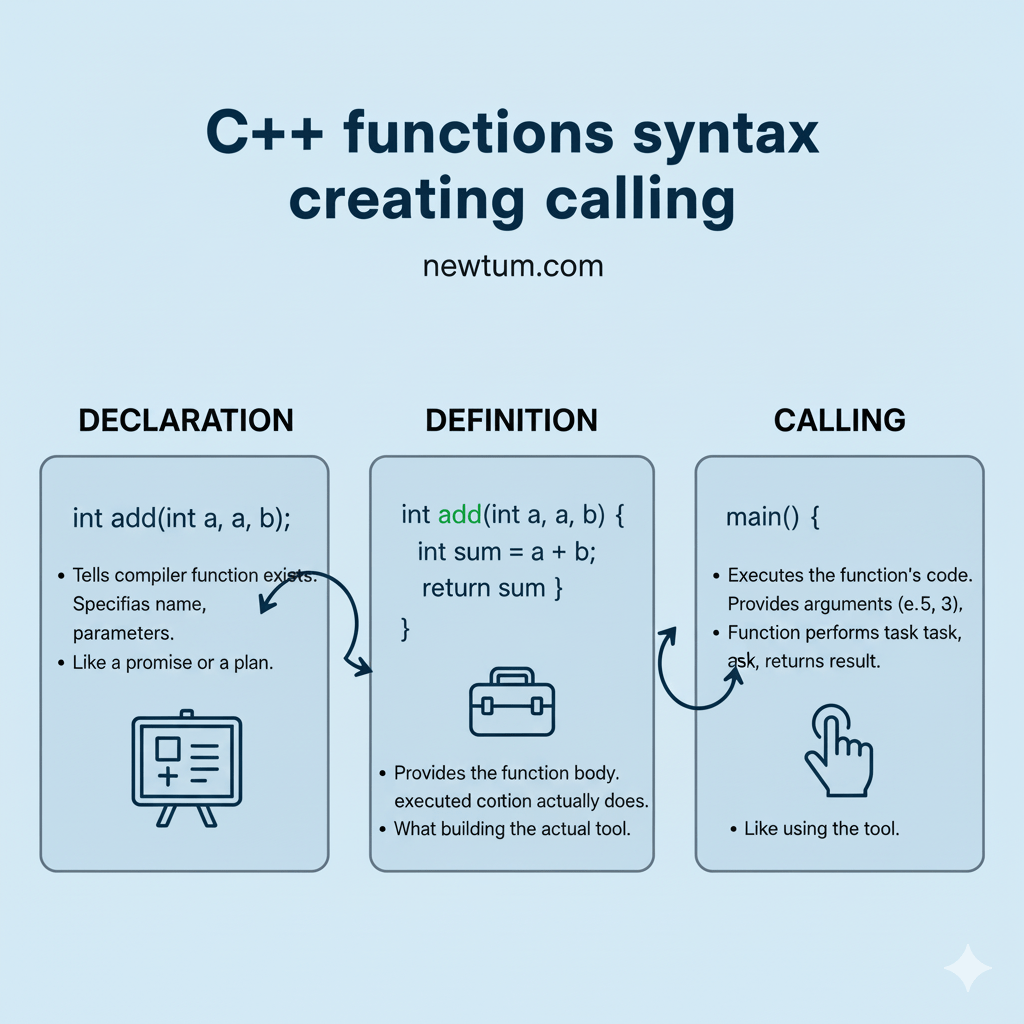A C++ function is defined using the syntax:return_type function_name(parameters) { // code }
You create a function by defining it with a return type, name, and parameters, then call it using its name followed by parentheses.
Functions in C++ are the building blocks of modular programming. They help you reuse code, make debugging easier, and improve program readability. Whether you’re a beginner or preparing for coding interviews, understanding how to create and call functions is a key C++ skill.
Key Takeaways of C++ Functions Syntax creating Calling
| Concept | Description |
|---|---|
| Function Syntax | return_type function_name(parameters) |
| Function Creation | Define with return type, name, and body |
| Function Calling | Use function name followed by () |
| Purpose | Code reuse and modular design |
What is a Function in C++?
A function in C++ is a block of code that performs a specific task and can be reused multiple times within a program. It helps break large programs into smaller, manageable parts, improving readability and reducing redundancy.
There are two main types of functions in C++:
- Built-in Functions: Already provided by C++ libraries, such as
sqrt(),printf(), andcin. - User-defined Functions: Custom functions created by programmers to perform specific operations.
Benefits of using functions:
- Enhances code reusability
- Makes programs modular and easy to debug
- Improves readability and maintenance
C++ Function Syntax

Every C++ function follows a specific structure. Here’s the general syntax of a C++ function:
return_type function_name(parameter_list) {
// function body
return value;
}
Explanation:
- return_type: The data type of the value the function returns (e.g.,
int,float,void). - function_name: The unique name used to identify and call the function.
- parameter_list: Optional input values (arguments) passed to the function.
- function body: Contains the actual code or statements to execute.
- return statement: Sends a result back to the calling function (optional if
void).
Example:
int add(int a, int b) {
return a + b;
}
How to Create a Function in C++

Creating a function involves declaring and defining it.
- Function Declaration (Prototype)
Informs the compiler about the function’s name, return type, and parameters.int add(int, int); - Function Definition
Contains the actual code that performs the operation.int add(int x, int y) { return x + y; }
Note:
You can declare a function before main() and define it after, ensuring the compiler recognizes it during the call.
How to Call a Function in C++
Once a function is defined, you can call it using its name followed by parentheses () and pass required arguments.
Example:
#include <iostream>
using namespace std;
int add(int a, int b) {
return a + b;
}
int main() {
int sum = add(3, 5); // Function call
cout << "Sum = " << sum;
return 0;
}
Output:
Sum = 8Here, add(3, 5) calls the function and passes two integers. The returned value (8) is stored in sum.
Function Parameters and Return Type
C++ functions can take parameters in different ways and return values of various types.
1. Pass-by-Value:
A copy of the variable is passed to the function. Changes inside the function don’t affect the original variable.
void display(int x) {
x = x + 5;
}
2. Pass-by-Reference:
The actual variable is passed, allowing modifications within the function.
void modify(int &x) {
x = x + 5;
}
3. Void Functions:
These functions don’t return any value.
void greet() {
cout << "Hello, World!";
}
4. Return Type Functions:
Functions that return values must use a return statement.
int multiply(int a, int b) {
return a * b;
}
Comparison of C++ functions syntax creating calling
| Feature | Functions in C++ | Inline Code (No Functions) |
|---|---|---|
| Readability | High | Low |
| Reusability | Yes | No |
| Debugging | Easier | Harder |
| Performance | Slight overhead | Fast but complex |
Applying C++ Functions in Everyday Coding
- Gaming Industry – Epic Games
Use Case: Epic Games uses C++ for creating game mechanics in their Unreal Engine. C++ functions are essential for creating game logic, rendering graphics and handling physics.
Code Snippet:
Output: Graphics rendered!#include void renderGraphics() { std::cout << "Graphics rendered!" << std::endl; } int main() { renderGraphics(); return 0; } - Technology Sector – Microsoft
Use Case: Microsoft leverages C++ for their system software and applications such as Windows OS, relying on functions to optimize performance and resource management.
Code Snippet:
Output: Sum: 15#include int addNumbers(int a, int b) { return a + b; } int main() { int result = addNumbers(5, 10); std::cout << "Sum: " << result << std::endl; return 0; } - Finance Sector – JPMorgan Chase
Use Case: In the financial world, C++ functions are used to handle financial models and algorithms with high-speed requirements, crucial for real-time trading systems.
Code Snippet:
Output: Interest: 500#include double calculateInterest(double principal, double rate, double time) { return principal * rate * time; } int main() { double interest = calculateInterest(10000, 0.05, 1); std::cout << "Interest: " << interest << std::endl; return 0; }
C++ Functions Basics
Are you ready to dive headfirst into the world of C++ functions but want to make sure you’re asking the right questions? You’re in luck! Here’s a list of burning queries on C++ function syntax, from creating functions to calling them, that don’t get enough attention. Let’s break them down one by one!
- What’s the basic structure of a C++ function?
At its simplest, a function in C++ is composed of a return type, a name, parameters (optional), and a body. Here’s a quick example:
This function calculates the sum of two numbers and returns it. Pretty neat, right?int add(int a, int b) { return a + b; } - How do you make a function optional in terms of parameters?
You can assign default values to parameters like this:
If you callvoid greet(std::string name = "there") { std::cout << "Hello, " << name << "!"; }greet(), it’ll greet “there” by default! Handy, huh? - Why use function prototypes in C++?
Function prototypes let you declare a function before actually defining it. Imagine it like giving a heads-up to the compiler. For instance:
This tells the compiler what to expect later on.int multiply(int, int); // prototype int main() { std::cout << multiply(5, 4); } - What’s the difference between call by value and call by reference?
In call by value, a copy of the data is made. In call by reference, you use the actual variable. Here’s an example of call by reference:
It swaps values using actual memory addresses!void swap(int &x, int &y) { int temp = x; x = y; y = temp; } - Can you overload C++ functions? Why do it?
Yes, you can! Function overloading lets you use the same function name but with different parameters. It simplifies calls:
Whether adding numbers or concatenating strings, it’s namedint operate(int a, int b) { return a + b; } std::string operate(std::string a, std::string b) { return a + b; }operate(). Cool, right? - How does inline function differ from others?
Inline functions request the compiler to embed their code at the point of call, avoiding jumps:
Usinginline int add(int x, int y) { return x + y; }inlinecan sometimes mean faster execution. - What are recursive functions?
These bad boys call themselves to solve problems, making life easier in complex calculations. Check this out:
Tracking a factorial becomes straightforward!int factorial(int n) { if(n <= 1) return 1; return n * factorial(n - 1); } - How do you handle variable arguments in functions?
Use ellipsis syntax along with<cstdarg>to manage them:
When exact parameters aren’t known, this is your go-to method!#include <cstdarg> int sum(int num, ...) { va_list args; va_start(args, num); int total = 0; for(int i = 0; i < num; ++i) { total += va_arg(args, int); } va_end(args); return total; } - How do you use function pointers?
Function pointers store addresses of functions and call them indirectly:
They’re perfect for callbacks and dynamic function calls!int (*funcPtr)(int, int) = add; std::cout << funcPtr(3, 7);
Armed with these questions and insights, you’re all set to explore C++ functions like a pro! Each query opens up a world of possibilities, so dive in and start coding! Isn’t it more fun than it seemed at first? Happy coding!
Discover the ease of coding with our AI-powered cpp online compiler. Instantly write, run, and test code, making programming smoother and more efficient. Perfect for beginners and experts alike seeking a seamless coding experience. Empower your projects with advanced AI assistance today!
Conclusion
Completing ‘C++ functions syntax creating calling’ enriches your coding arsenal by enhancing efficiency and readability. It’s a gateway to mastering complex problem-solving. Why not challenge yourself today? Dive deeper into coding realms with Newtum and unlock endless programming possibilities, including Java, Python, and beyond.
Edited and Compiled by
This article was compiled and edited by @rasikadeshpande, who has over 4 years of experience in writing. She’s passionate about helping beginners understand technical topics in a more interactive way.



